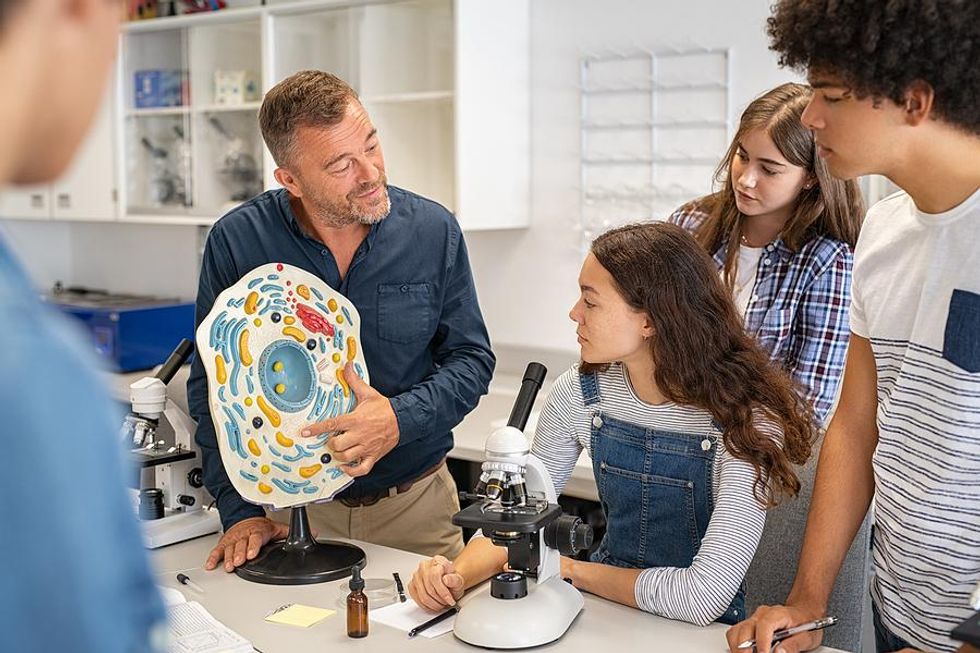8 Education Industry Leaders Speak Out: How To Address Teacher Shortages

Within the United States, many state departments of education are lowering teacher certification requirements to meet the demands of the current teacher shortage. In New Jersey, for example, aspiring educators no longer need to take PRAXIS exams. In Arizona, people are now allowed to teach in school with just a high school diploma (and current enrollment in university). In New Mexico, the National Guard has been activated as substitute teachers.
As a teacher coach, I support the development of many types of educators—those trained in traditional university school programs and those who participated in alternative route pathways. I, myself, was an alternate route teaching candidate who took certification courses on nights/weekends in New Jersey. While I am now able to pay it forward by mentoring new educators, it did take several years of me teaching students to gain my “sea legs” in the trade. As a result, I do sometimes wonder if I was able to fully support those first few cohorts of students whom I taught. I also know, however, that even going through formal university teaching programs is no guarantor of success in teaching as all new teachers must adapt to the local school community and cultural conditions where they work.
The recruitment and retention of quality teachers is, therefore, a topic of much importance. Because I assume that others in education also see this situation as a five-alarm fire, I decided to ask education industry leaders, including those in other industrialized nations, if they agree or disagree with the easing of teacher certification requirements, and how we might best retain the teachers we already have. Here are their thoughts:
American Association Of Colleges For Teacher Education (AACTE)
 Bigstock
BigstockVice President for Research, Policy & Advocacy
According to a 2019 report from the Economic Policy Institute, “The teacher shortage is real, large and growing, and worse than we thought.” There have been consistent needs in areas like ESL, special education, and STEM for many years. Post-pandemic, the teaching profession has experienced a massive upheaval. We are now seeing shortages of fully licensed and credentialed educators across all disciplines and all communities.
In response to the shortage of profession-ready educators, states are lowering standards for entry into the profession and schools are hiring people with emergency or provisional licenses who are not fully prepared to enter the classroom and meet the academic or social/emotional needs of our K-12 students. These practices are antithetical to the profession that builds all other professions, the national economy, and the security of the nation.
Bottom line: Every parent wants their child in a classroom led by someone who knows how to teach and how children learn. Lowering certification requirements endangers children’s learning and their future life outcomes. It also creates increased churn in the educator workforce, causing districts to spend more money to fill shortages in the future. We are already witnessing the never-ending cycle of replacing unprepared people with more unprepared people.
Recruiting and retaining high-quality educators for the teaching profession has become more difficult as the teaching talent pool is attracted to other occupations with higher salaries, better working conditions, and more respect. By addressing compensation and treating teachers with respect for the important work they do, we can better retain current educators in the field.
Retention begins with preparation. Grow Your Own and residency programs are evidence-based, sustainable models that increase the supply of profession-ready educators. These models have the added benefit of attracting a diverse staff who already work at the schools and live in the communities they will serve when they graduate. By scaling evidence-based preparation programs, we can ensure fully licensed teachers enter the classroom ready for a career in education.
At AACTE, our members are eager to fully prepare people who have already entered the field on emergency or provisional licenses. We encourage districts to partner with their local college or university in supporting new, unprepared teachers to become profession-ready by enrolling in educator preparation programs.
Australian Institute For Teaching And School Leadership (AITSL)
 Bigstock
BigstockChief Executive Officer
AITSL collects and collates data that gives a clear picture of supply issues across the nation, and that picture is stark.
Data from our Australian Teacher Workforce Data initiative shows approximately 16% of our teaching workforce are approaching retirement age and we don’t have enough people entering the initial teacher education pipeline to meet current and future shortfalls. Additionally, data published by AITSL in late 2021, drawing on the largest ever survey sample of Australian teachers, shows that 25% of the teacher workforce indicate they are likely to leave the profession before they retire, with approximately half of them (13% of the workforce overall) intending to leave in the next 10 years.
The current issues affecting the teacher workforce require flexible approaches—without trading off standards—to match the supply and demand of teachers, speed up entry into the classroom, and improve the quality of pre-service teachers’ practical experience within initial teacher education.
However, the increase in teacher supply to meet current and future demand must not compromise quality teaching, including the need to meet nationally agreed standards to graduate from a teacher education course and to register as a teacher in Australia. This will be very difficult for our education employers, but we know how critical it is, given teacher expertise is the greatest influence in schools on outcomes for Australia’s 4 million students.
The key to attracting and retaining teachers is professional status. A national strategy to raise the status of the teaching profession could include a series of comprehensive, evidence-based actions to further professionalise the teacher workforce, leading to improvements in self-efficacy, confidence, and work satisfaction.
Australia needs to take comprehensive action now to attract and prepare high-quality teacher candidates, deploy them where they are needed, ensure they are appropriately inducted into the profession, provide opportunities for their ongoing development and recognition of teaching expertise, and, ultimately, retain them in the profession long term.
To read more about the work AITSL does and read our latest research reports, visit our website.
How To Navigate Life, LLC
 Bigstock
BigstockPartner and Book Author
First off, making it easier for people to become educators is unequivocally a good thing. We need more teachers, especially those from underserved and marginalized populations.
However, reducing the training and requirements needed to become a teacher isn't addressing the root cause of teacher shortage: teacher retention, not recruitment, is driving this crisis. Ninety percent of teaching positions that need to be filled are the result of beginning and mid-career teachers leaving the profession.
To address the root cause, we need to focus our energy on retaining the teachers we have.
That starts by valuing teaching as an essential vocation. The United States rose to prominence by fostering and developing a diverse array of talented people. High-quality universal education was the engine of our achievement.
Less than one in three educators think that their work is valued by our society.
Now a wide array of actors is trying to undermine teachers further by controlling what they teach and how. This only happens in education: people don't feel entitled to tell doctors, lawyers, or firefighters how to do their jobs because we realize they are trained professionals.
Why aren't teachers afforded the same respect? Somehow, we have forgotten how essential and important a highly educated citizenry is. If we truly want to solve the teacher shortage, we must start respecting them first.
Learning Policy Institute
 Bigstock
BigstockExecutive Director
The simple answer is no. Lowering certification requirements simply kicks the can down the road while negatively impacting students and schools. Uncertified teachers and teachers who enter the profession through alternative routes leave at much higher rates than their fully prepared peers. Students learning from underprepared teachers also score significantly lower in both mathematics and English Language Arts. Additionally, the increase in staff turnover that results from hiring underprepared teachers has consequences beyond individual classrooms, as the entire school suffers from staff churn and the influx of new, less effective teachers.
A better solution is to lower the financial barriers to enter the profession through scholarships and loan forgiveness programs. Creating incentives to enter the profession is especially critical as the teacher pipeline continues to shrink. If financial barriers are removed, candidates can afford to prepare for teaching through a year’s worth of coursework integrated with extensive clinical practice. One promising approach is teacher residencies. Building on the medical residency model, teacher residencies provide a pathway to teacher certification grounded in deep clinical training. Residents apprentice alongside an expert teacher in an underserved classroom for a full academic year. Research shows that residency models increase the diversity of the teaching profession, improve teacher retention, and positively impact student learning.
Strengthening teacher preparation through high-quality pathways like residencies addresses shortages in relatively short order and promises benefits for students and staff alike. Although there are clearly some upfront costs to investing in a full year of high-quality preparation, districts have found innovative approaches to sustaining residencies while reaping the benefits in terms of stable school staffs and lower costs of constantly hiring underprepared teachers. Rather than rush into a band-aid solution by lowering teacher certification requirements, policymakers can turn to evidence-based, long-lasting solutions.
National Center For Grow Your Own (NCGYO)

Bigstock
Managing Partner
States are doing their best to respond to the teacher shortage crisis that has been a long time coming. I will always agree that the best recruitment strategy is having a better retention strategy. However, to get more people into the profession, one option for states to consider is investing in Grow Your Own programs and registered apprenticeships in teaching that allow aspiring educators to become a teacher for free and get paid to do so.
National Council On Teacher Quality (NCTQ)
 Bigstock
BigstockPresident
Our nation’s teachers have navigated the challenges of the last few years with innovation, grace, and commitment. Many teachers have been left feeling depleted, as is reflected in recent surveys and news stories. So, in response, are teachers leaving classrooms in droves? No, the nation is not facing an overall, widespread teacher shortage, according to the available data.
There is a shortage of teachers for certain schools, such as those with high percentages of students living in poverty, and in certain hard-to-staff subjects, such as special education and STEM—and this has been the case for a number of years, well before the pandemic. We also know from decades of research that it is our most vulnerable students—students living in poverty, students of color, English language learners, and students with disabilities—who are assigned at higher rates to less qualified, less experienced, and less effective teachers.
The last thing we should be considering, then, is lowering requirements for teachers to earn a license. Students need teachers who are skilled and knowledgeable, especially now in the wake of the pandemic. Policy solutions that make it easier to become a teacher are overly broad, short-term solutions that amount to saying we just need “warm bodies” in classrooms. It’s harmful to students and to the teaching profession.
To be successful, teachers must know the subject matter as well as the science of learning and how to support their individual students. Rather than lowering expectations to become a teacher, we need targeted policy solutions that will help prepare, recruit, and retain teachers. This means working with teacher preparation programs to make sure aspiring teachers get the knowledge, skills, and practice they need to succeed, investing in student teaching and apprenticeship programs that connect aspiring teachers to the schools and positions with the highest demand, and targeting compensation to attract and retain teachers to reach the students and schools that need them the most.
The New Teacher Project (TNTP)

Bigstock
Chief Executive Officer
There are many reasons that school systems are currently struggling to hire teachers, most of which pre-date the COVID-19 pandemic. Pay is too low; job requirements are nearly impossible; pipelines are weak. In response, many states are reforming teacher certification requirements. While this alone will not solve teacher shortages, changing certification to be based on actual teaching ability can contribute to a stronger, more diverse teacher workforce.
This idea guides our own teacher training programs. Our approach to teacher preparation is grounded in three goals:
- Breaking down barriers to access to diverse communities.
- Incorporating high-quality development experiences and a high bar for teacher performance.
- Providing differentiated support that is informed by continuous progress monitoring and improvement.
Unfortunately, teacher certification requirements can work against those goals. Most states require prospective teachers to pass one or more standardized tests, usually from the Praxis series, to earn even a provisional license. These tests are costly to take and administer, are weak predictors of teaching ability, and they screen out a disproportionate number of teachers of color, undermining goals around teacher quality and diversity. Given that we need an additional one million teachers of color, these tests are a significant barrier.
We see this every year in our programs. Teachers with a proven ability to lead their kids to big academic gains (as reflected in test scores, classroom observations, and other measures) face the prospect of losing their jobs because of their Praxis scores. We also see plenty of teachers who pass the tests but struggle in the classroom.
There is a better approach. Instead of relying on standardized tests, states can refocus licensure rules on actual teaching ability. These measures don’t have to include or be limited to standardized test scores: classroom observations, assessments of student work, and student surveys can provide valuable information as well. In short, let’s stop relying on proxies and base certification on what really matters for our students.
To be clear, this change alone isn’t enough. If we don’t also improve the value proposition for becoming a teacher, we can’t sustainably fix the problem. But this common-sense change can start to move us in the right direction.
Teacher Development Trust (United Kingdom)
 Bigstock
BigstockChief Executive Officer
Here in the United Kingdom, we’ve also been struggling to get enough teachers. In fact, this current year looks like one of the toughest on record when it comes to recruiting teachers onto initial teacher education programmes.
Like many other countries, we’ve been worried for some years about retention, although I don’t think I’ve yet seen robust evidence that retention has become a significantly larger problem here since the pandemic. Nonetheless, government in England (because Wales, Scotland and Northern Ireland have their own independent education systems, much like separate states in the USA) has been pursuing a few key policies.
Firstly, government has been raising starting pay for teachers. Even though England’s average teacher pay was good by international comparison, our starting salaries were relatively low. Secondly, we’ve added much more funded and structured support for new teachers. Where previously we had one year of support after graduation, now there are two years of support with schools funded to reduce teaching loads and also funded to provide a trained mentor and a more structured induction programme. Thirdly, government is current going through a major re-accreditation of initial teacher training providers, asking all of them to show how they will meet tougher standards in order to continue. All three policies are facing challenges, particularly with high inflation, economic challenges, and employment market challenges, but the approach here has been to try and maintain or even raise the bar and use support, pay and national advertising campaigns to attract more teachers.
My own organisation, the Teacher Development Trust, a non-profit, focuses on how we create the conditions and leadership to ensure that teachers stay and improve. We train leaders in approaches to improve organizational strategy, professional development, and leadership, based on our research on leadership and culture, with government-funded programmes to train new leaders. This seems particularly vital right now—if we’re going to struggle to get new teachers then we’ve really got to, to coin a phrase from Professor Dylan Wiliam, ‘love the ones we’re with.'
Takeaways On Teacher Shortfalls And Easing Of Certification Requirements
 Bigstock
BigstockWhile opinions differ on whether we should be lowering teacher certification requirements, or even if we were ever looking at the right things when recruiting teachers (i.e., focusing too much on new teacher GPAs/test scores), many industry leaders call for ongoing and differentiated teacher professional development and training regardless of how teachers come into the profession. Grow Your Own models, teacher residencies, and apprenticeships in teaching are professional development strategies that are becoming increasingly popular ways through which to address ongoing teacher training needs.
Many of the voices in this article also call out the importance of valuing our teachers as professionals, be that in the United States and/or globally. If we aim to retain teachers and stop the never-ending cycle of hiring, quitting/firing, and rehiring teachers, particularly in traditionally marginalized communities, we need to consider how best to raise teacher pay, make the job of teaching sustainable, and offer ongoing teacher recognition. As David Rosenberg, partner at Education Resource Strategies, adds, "we need to build into daily schedules the time for teacher collaboration and reduce the isolation that many educators feel." Providing professional development that is embedded, ongoing, and targeted to student needs can be a great first step in ensuring that our teachers feel appreciated.
If you would like additional ideas on how to impact student lives without sacrificing your own, and have a life teaching, check out my quick hack teaching courses here. You can also reach me on LinkedIn.
- 5 Reasons Why Teachers Are STILL Not OK - Work It Daily ›
- 8 Amazing Ways Teachers Can Spend Their Summer Break - Work ... ›
- 5 Job Search Tips For Teachers - Work It Daily ›
- What Teachers Should Know Before Interviewing With Schools ... ›
- 7 Best Summer Jobs For Teachers - Work It Daily ›
- 5 Common Teaching Mistakes That Stunt Student Growth - Work It ... ›
- 6 Things To Know Before Becoming A Teacher - Work It Daily ›
- Top 8 Career Choices For Women - Work It Daily ›
- How To Help Newly Arrived English Language Learners Thrive - Work It Daily ›
- 6 Things To Do To Prepare For Your Classroom Observation - Work It Daily ›
- The Best Jobs For Teachers Leaving Education - Work It Daily ›
- The Art Of Mentoring And Paying It Forward - Work It Daily ›

 Bigstock
Bigstock Bigstock
Bigstock Bigstock
Bigstock


